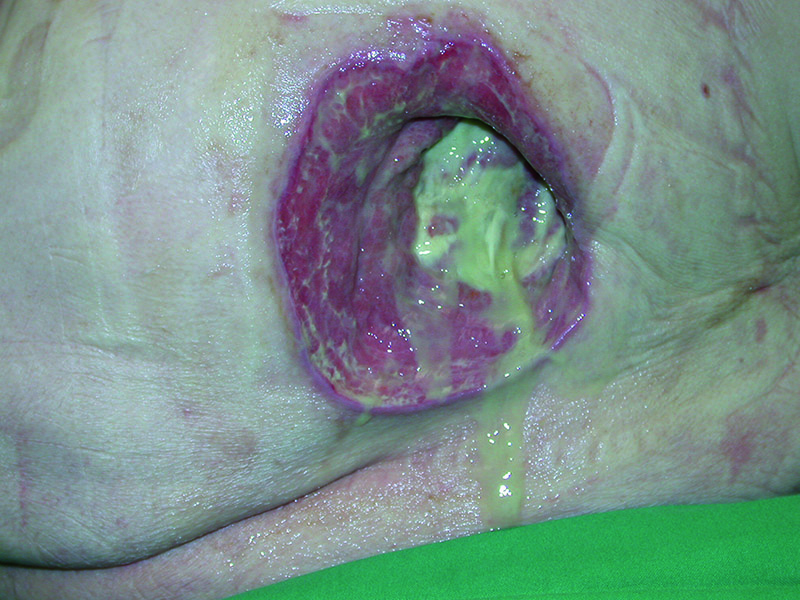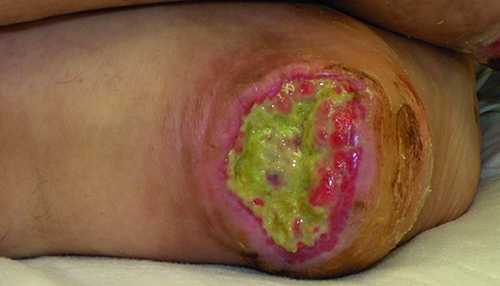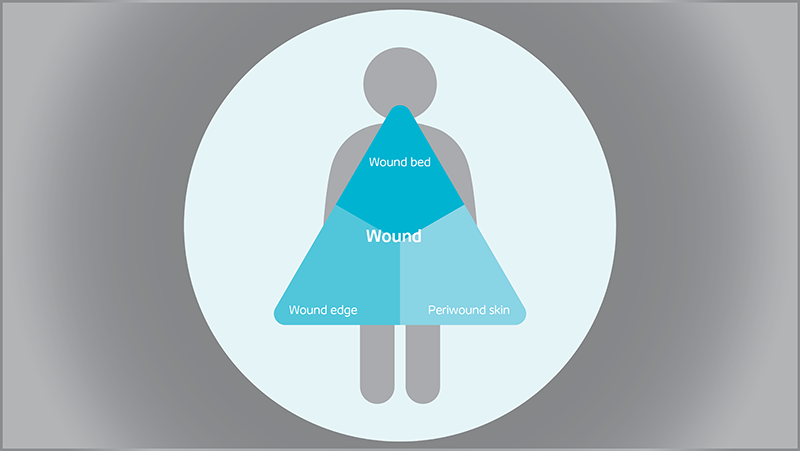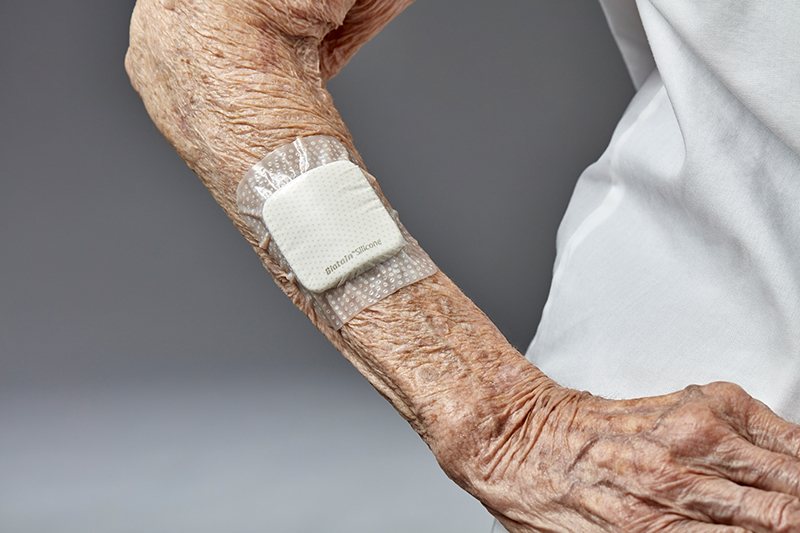How to assess pressure injuries
In this section, you’ll learn about:

Conduct a holistic pressure injury assessment
Thebest way to develop an appropriate management plan, is to conduct a comprehensive assessment of both the individual and their pressure injury. Your assessment should cover all the factors influencing your patient’s health and well-being, including their:
- complete health/medical, psychological and social history;
- physical and functional capacity;
- nutritional status;
- health-related quality of life, self-care skills and knowledge;
- available resources and support network; and
- ability to follow a prevention and management plan.1
To help you conduct a holistic assessment of the patient and their pressure injury, try using The Triangle of Wound Assessment. This tool will ensure that you are consistent in your patient and wound assessment; it will also help you to choose the optimal treatment for your patient.
You can read more about the Triangle of Wound Assessment here.
What to look for in your assessment
Each time you assess the pressure injury, you should consider the pressure injury’s:1
- stage or category;
- location;
- size (length and depth);
- tissue type (e.g. closed, epithelial, granulation, slough or eschar);2
- colour;
- periwound condition;
- wound edges (e.g. rolled, flat, irregular, tunnelling or undermined);
- exudate, or fluid; and
- odour.
How often should I assess the pressure injury?
After you conduct an initial assessment, you should reassess the pressure injury at least once a week. This will help you monitor the injury’s healing progress. If you don’t see any signs of healing after two weeks of appropriate care and treatment, you should conduct a comprehensive reassessment of your patient.1
TIP: Use photographs.
Taking photographs of your patient’s pressure injury can help you to assess the injury and monitor its progress.2 If you use photographs, make sure you use the same technique and equipment each time, so you can have a reliable way of comparing the wound’s progress over time.1

How to identify signs of infection
Pressureinjuries occur because of lack of blood flow to a particular part of the body. The tissue in this area doesn’t receive nutrition, oxygen, immune cells, antibodies and antibiotics from the blood. This makes pressure injuries more vulnerable to infection.1
In addition, most Stage 3 and 4 pressure injuries occur in older individuals. They often have other conditions (co-morbidities) that both increase their risk of pressure injuries developing and impair wound healing.1
When you assess a wound, you should look for signs of infection. The pressure injury could be infected, if it:
- doesn’t heal for two weeks;
- has friable (fragile or weak) granulation tissue;
- has malodour;
- is increasingly painful;
- has increased heat in the surrounding tissue;
- has more exudate or if the exudate changes (e.g. is bloody or purulent)
- has increased necrotic (dead) tissue; or
- has pocketing or bridging in the wound bed.
If you see one or more of these signs, the pressure injury could be infected. In our section on wound infection, you’ll learn more about the signs of infection and how to treat an infected wound.
If the pressure injury is infected, you will need to select a dressing that can help you to treat the infection. Read more about dressing selection here .
Managing wound exudate
Wound exudate, or fluid, plays an essential role in the healing process.3 However, exudate can also stop a wound from healing. For example, if a wound produces too much exudate, it can begin to pool. Pools of exudate can cause harmful bacteria to grow in the wound. 4,5,6
And if exudate begins to leak onto the skin surrounding the wound, it can weaken the skin. This, in turn, can delay wound healing. 7,8,9,10 To keep this from happening, it’s important to remove excess exudate from the wound. You can do this by using an absorbent dressing (new link) that can contain exudate under pressure.11
References
- European Pressure Ulcer Advisory Panel. National Pressure Injury Advisory Panel and Pan Pacific Pressure Injury Alliance. (2019) Prevention and Treatment of Pressure Ulcers/Injuries: Clinical Practice Guideline. Emily Haesler (Ed.) EPUAP/NPIAP/PPPIA.
- Defloor, T., Schoonhoven, L., Katrien, V., Weststate, J., Myny, D. (2006). Reliability of the EPUAP classification system. Journal of Advanced Nursing. 54(2):189-98.
- Lloyd Jones, 2014
- Snyder RJ Managing dead space: an overview. Podiatry Management. October 2005.
- Cutting K et al. Topical silver-impregnated dressings and the importance of the dressing technology. 2009 The Authors. Journal Compilation © 2009 Blackwell Publishing Ltd and Medicalhelplines.com Inc, International Wound Journal, Vol 6 No 5
- Waring M et al. An investigation into the conformability of wound dressings. Wounds uk, 2011, Vol 7, No 3
- Adderley, U. J. (2010) Managing wound exudate and promoting healing. British Journal of Community Nurses, 15(3), 15-20.
- Mouës, C. M., Heule, F., Legersteen, R., Hovius, S . E. R. (2009). Five Mellennia of Wound Care Products – What is New? A Literature Review. Ostomy Wound Management. 3; 16-32.
- Sibbald, R., Williamson, D., Orsted, H., Campbell, K., Keast, D., Krasner, D. Sibbald, D. (2000). Preparing the Wound Bed - Debridement, Bacterial Balance, and Moisture Balance. Ostomy Wound Management. 46(11):14-35.
- Haryanto H et al. Relationship between maceration and wound healing on diabetic foot ulcers in Indonesia: a prospective study. Int Wound J 2017; 14:516–522.
- WUWHS (2019) Consensus document wound exudate effective assessment and management
You may also be interested in…

HEAL e-learning
Learn how to assess and manage pressure injuries with this EWMA-endorsed course.

Patient case video
Watch how a pressure ulcer on the right heel was managed with a silicone foam dressing.

Triangle of Wound Assessment
Conduct a holistic and systematic wound assessment with our tool.

